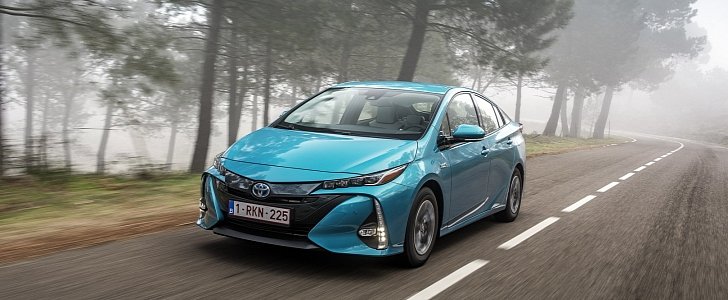The Toyota Prius could rapidly become the most popular plug-in vehicle in Britain, after the manufacturer announced it's slashing prices by £3200 at launch, making it much cheaper than the previous generation and the BMW 330e iPerformance.
The entry-level Business Edition Plus costs £31,695, while the range-topping Excel model is priced at £33,385. All models are eligible for the Government's £2,500 grant for plug-in hybrid (PHEV) buyers, which means you can grab one of these from £29,195.
Obviously, no car is perfect, but Toyota have been at it for over 20 years, and they know a lot about efficiency. Besides being more efficient, the 2017 model is much cooler than its predecessor. The aesthetics make it pretty appealing at the front, almost like a Lexus, while the back end offers a carbon fiber trunk.
Even though the PHEV uses the same 1.8-liter gasoline engine as the regular Prius launched last year, it matches it to a larger 8.8kW/h lithium-ion battery pack and a dual motor drive system.
The official rating of 283 mpg seems impossible to achieve in the real world. The CO2 emissions are 22g/km, 48g/km less than the standard and 17 grams below the Golf GTE. However, as good or bad your eco-driving skills are, this will be a very cheap car to run.
The Prius is based on that new platform that also underpins the C-HR. That makes it lighter and more fun to drive. It's also got better soundproofing, plus it makes for a decent family car. The trunk is long and completely flat, while the portrait-style infotainment screen will keep passengers occupied. The Prius PHEV is 165mm longer than its predecessor, 15mm wider and 20mm lower.
Charging times have also been improved, thanks to an increase in the maximum power that the system can handle, up from 2.0 to 3.3kW. With a Type II Mennekes connector, it takes 2 hours to fill 2/3 of the battery. It can even drive at motorway speeds purely on electricity.
Obviously, no car is perfect, but Toyota have been at it for over 20 years, and they know a lot about efficiency. Besides being more efficient, the 2017 model is much cooler than its predecessor. The aesthetics make it pretty appealing at the front, almost like a Lexus, while the back end offers a carbon fiber trunk.
Even though the PHEV uses the same 1.8-liter gasoline engine as the regular Prius launched last year, it matches it to a larger 8.8kW/h lithium-ion battery pack and a dual motor drive system.
The official rating of 283 mpg seems impossible to achieve in the real world. The CO2 emissions are 22g/km, 48g/km less than the standard and 17 grams below the Golf GTE. However, as good or bad your eco-driving skills are, this will be a very cheap car to run.
The Prius is based on that new platform that also underpins the C-HR. That makes it lighter and more fun to drive. It's also got better soundproofing, plus it makes for a decent family car. The trunk is long and completely flat, while the portrait-style infotainment screen will keep passengers occupied. The Prius PHEV is 165mm longer than its predecessor, 15mm wider and 20mm lower.
Charging times have also been improved, thanks to an increase in the maximum power that the system can handle, up from 2.0 to 3.3kW. With a Type II Mennekes connector, it takes 2 hours to fill 2/3 of the battery. It can even drive at motorway speeds purely on electricity.










